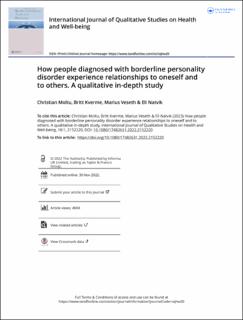| dc.contributor.author | Moltu, Christian | |
| dc.contributor.author | Kverme, Britt | |
| dc.contributor.author | Veseth, Marius | |
| dc.contributor.author | Natvik, Eli | |
| dc.date.accessioned | 2023-08-14T12:19:32Z | |
| dc.date.available | 2023-08-14T12:19:32Z | |
| dc.date.created | 2023-03-08T12:49:26Z | |
| dc.date.issued | 2023 | |
| dc.identifier.issn | 1748-2623 | |
| dc.identifier.uri | https://hdl.handle.net/11250/3083873 | |
| dc.description.abstract | Background The first-person experiences of people diagnosed with borderline personality disorder (BPD) is an important area of research. It can support clinical and ethical practice, and nuance and expand on insights offered by diagnostic and treatment-oriented research approaches. In this study, we aimed to develop knowledge about how persons who were recently diagnosed with BPD experience being in relationships with themselves and others. Methods We conducted in-depth life-world interviews with 12 women recently diagnosed with BPD. The interviews focused on their lived experiences of relationships to self and others. All participants gave their informed consents to participate. We analysed the data with a structured approach to reflexive thematic analysis, conducted as a team-based approach. Results We extracted an overarching theme, “Reaching for firm holdings”, that is the most abstract interpretation of participants’ experiences. The five subordinate themes (“Captive of emotions”, “Keeping undeservedness at bay”, “Distrusting oneself”, “Dependence as stability” and “The uncertainty of reaching out”) are specific constituents of the overarching theme, and provide detail and variations across individual accounts. Conclusions The results suggest that the experience of relationship to self and others of people recently diagnosed with BPD entails feeling insecure, unsafe and frightened. We report five themes that describe ways participants seek to cope with this situation. The results indicate that their experiences encompass turning to others, or to objects, for feelings of safety. As such, the experience of relationship to self and others in the context of receiving a BPD diagnosis seemed to entail finding and evolving strategies to protect a vulnerable self. Self-harm, suicide attempts and addiction all seemed to be ways of handling and tolerating chaotic and frightful emotions. One major limitation of our study is that only people who identified as female were recruited to participate in the study. | en_US |
| dc.language.iso | eng | en_US |
| dc.publisher | Taylor & Francis | en_US |
| dc.rights | Navngivelse 4.0 Internasjonal | * |
| dc.rights.uri | http://creativecommons.org/licenses/by/4.0/deed.no | * |
| dc.title | How people diagnosed with borderline personality disorder experience relationships to oneself and to others. A qualitative in-depth study | en_US |
| dc.type | Journal article | en_US |
| dc.type | Peer reviewed | en_US |
| dc.description.version | publishedVersion | en_US |
| dc.rights.holder | Copyright 2022 The Author(s) | en_US |
| dc.source.articlenumber | 2152220 | en_US |
| cristin.ispublished | true | |
| cristin.fulltext | original | |
| cristin.qualitycode | 1 | |
| dc.identifier.doi | 10.1080/17482631.2022.2152220 | |
| dc.identifier.cristin | 2132355 | |
| dc.source.journal | International Journal of Qualitative Studies on Health and Well-being | en_US |
| dc.identifier.citation | International Journal of Qualitative Studies on Health and Well-being. 2023, 18 (1), 2152220. | en_US |
| dc.source.volume | 18 | en_US |
| dc.source.issue | 1 | en_US |

